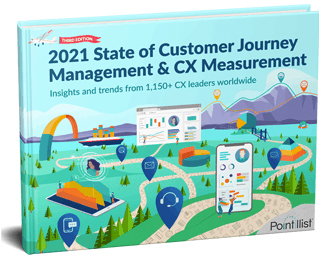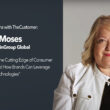On the heels of their recent report, “State of Customer Journey Management and CX Measurement” Steve Offsey, VP Marketing at Pointillist, recently sat down with TheCustomer to talk about their insights, what sets CX leaders apart, and how high-performing organizations are managing complex CX undertakings.
 The 35 page report organizes the data around 5 major findings:
The 35 page report organizes the data around 5 major findings:
- High-performing teams align their organization around journeys.
- Quantifying the ROI of customer experience initiatives remains the top CX challenge.
- Digital Transformation Succeeds by Focusing on the Customer.
- CX and Marketing Don’t See Eye to Eye.
- Organizations Still Struggle to Deliver Consistent Omnichannel Experiences.
“Companies that report tight alignment between CX and marketing are outpacing their competitors,” added Offsey. “The most successful teams use customer journeys to align their goals and initiatives. Brands must market themselves in a way that’s consistent with their customers’ actual experience if they want those customers to keep coming back.”
To download the full report, visit: The State of Customer Journey Management and CX Measurement in 2021
Below is the full transcript of our conversation.
TheCustomer
Today I have Steve Offsey, who is VP of Marketing for Pointillist, who will talk to us a little bit about the findings more a recent survey they’ve done, which I believe is the third year in a row for this kind of thing. But also more broadly about what’s happening in the world of CX and the way brands are approaching that discipline. So Steve, first of all, thanks for your time and for joining me.
Steve Offsey
Thanks, Mike. Glad to be here.
TheCustomer
So this survey is really interesting, because now there’s some some longitudinal data to look at. And I think listening to you talk about it and reading what’s in the in the report, there’s a certain amount of maturity that’s becoming evident in the way, let’s just say some brands – but not all brands – are approaching CX. Can you talk a little bit about? Let’s just let’s just frame it up this way. Journey management and the ways that top brands are using it.
Steve Offsey
Sure. When we started this report three years ago, journey management was not well known at all, even amongst CX-forward organizations. And over the last three years, what we’ve seen is a definite trend towards more organizations adopting a journey-based approach to CX. And what we mean by journey management is defining what customer journeys exist right from the outset, then being able to measure within the context of those journeys, how what’s working, and what isn’t, how they’re performing, and then being able to engage with customers in the context of those journeys. That is, sort of journey management in nutshell. And what we’ve seen over the last three years is a definite trend toward more organizations taking a journey management approach to doing their customer experience.
TheCustomer
Almost by definition, CX is a function that that – to be effective needs to cross silos and connect functions. And what the latest report seems to be saying, among other things, is that there’s a long way to go to achieve that. Why do you think that is?
Steve Offsey
Absolutely. What we’re seeing is a large disparity between what we’re grouping into a category we’re calling the high performers who are people whose CX is producing value – and is recognized by the organization that this is making not only the customer’s life better, but improving the organization’s performance. And what we’re calling the underperformers, who are people in organizations where no one sees any progress, they don’t see any outputs being improved for the company. And what we see is that the high performers at this point are just totally embracing a journey-based approach. And it goes beyond just measuring and managing journeys, but it extends all the way to organizational design. So nearly 70% of the respondents who are in high performing organizations reported that they had dedicated roles or teams organized around journeys, compared to only 35% of the underperformers. So, this is one of the things we’re seeing in those organizations is not just talking the talk, but walking the walk and saying if our customers are seeing us as a company organized in a certain way, we need to be able to respond and interact with them, not by the functions that we have internally, but by the journeys our customers are taking.
TheCustomer
It seems to me that a large part of enterprise CX, let’s just call it “change management” because there would seem to be a lot of organizational kind of re-formation along these new lines, which are not traditionally measured or tracked and maybe not traditionally valued even for that reason. So, how does someone like Pointillist with your platform, manage that kind of cultural adaptation?
Steve Offsey
Well, Pointillist provides a SaaS platform that enterprises use to basically operationalize journey management. And what that means is that the platform tracks the journeys that your customers are taking so that you can measure how customers are performing on those journeys, whether they’re reaching their goals, whether there are blocks, blockages on the way that are causing them to leak out of that journey or at knock or just drop out and not complete it, and then also orchestrate actions to help the customer better achieve the goal they’re looking for in that journey.
It also, though, uniquely allows organizations to collaborate around journeys, because if you’re truly want to be a customer centric organization, you have to do more than just say, we’re going to be customer centric, you need to actually have your employees work in a way that’s oriented around how the customer wants to interact with you and what their goals are, which is the endpoint of the journeys that they’re taking. So, what the platform allows you to do is take an organization that is in siloed functions, traditional functions, but actually collaborate in a journey-based context.
So, if your customer, for example, is on a journey, say you’re in a bank, and it’s a money transfer journey, anyone that’s involved with that could be collaborating. We’re saying there’s a point where there’s a problem in this journey. Customers who are on the website are leaking out and calling into the call center. There’s an issue, your employees immediately will be able to get alerted that there’s a problem in that journey, and jump into action mode to fix it, and collaborate with people across functions, whether it’s marketing, CX, the call center, the IT group, whoever your product, digital product owners are, and all quickly coalesce, understand what the root cause of the problem is, and then implement actions to solve it.
TheCustomer
So, I’ve seen the Pointillist platform, and quite frankly, I don’t see anything else out there that gives CX practitioners that level of data and insights, especially modeling different journey scenarios. My question is, and you alluded to this earlier, there are the high performing CX companies, and then there’s kind of everybody else – are there any commonalities that you can find other than, you know, organizational readiness, but are there certain college sectors that are that are maybe more ready for this kind of thing than others?
Steve Offsey
One of the things that came out of the survey is that the degree of alignment is so much higher in high performers than underperformers. And in one of the areas that’s most critical for alignment turns out to be not surprisingly CX and marketing. So, in underperformers CX and marketing were not very aligned. And what I mean by that is that the CX team, and the marketing team in the underperformers would say that they’re aligned on customer experience, the marketing team would say it’s a number one priority, the marketing team would say that they have customer centric goals. But in the underperformers, the CX team wouldn’t be great. It was quite a disparity there. So, marketing thought it was customer centric and CX and those organizations said no, we’re we don’t see I in the high performers, they were aligned.
So, in the high in the high performers, they were two times more likely to regularly collaborate on CX initiatives between marketing and CX. And they were also more likely to be tightly aligned on customer-centric approaches and goals than the underperformers.
TheCustomer
So, can we draw a connection between marketing and CX departmental alignment and whether CX lives within the marketing realm? Or if it lives, say under a CIO or CTO in the organization, is there a connection we can make there? And if it is, is it a valid one?
Steve Offsey
There was a definite dependency in how aligned CX and marketing were. In high performers, the alignment was far, far tighter than in underperformers. And it pretty much went across the board across industries. Really, and again, I think that’s just a typical to the iceberg example of the alignment you need across the entire company.
But there was one very interesting one that jumped right out. Because, again, most marketers, when you talk to them will say, of course, we’re customer centric. But the CX teams, and a lot of the companies who are not performing well on CX said, No, you know, you’re not. And that’s where we think, journey management can be used as a motivator for companies to improve that alignment, change the way their marketing team prioritizes and get better aligned with – not just CX, but with product teams with customer success and customer support teams. And,
you know, contact center care contact center teams all across the company.
“A customer journey is the customer’s path to accomplish the goal the customer wants to achieve.”
TheCustomer
What specific questions should CX leaders be asking of their organizations to try and understand whether that alignment exists, could exist, potentially, or just has no chance of existing?
Steve Offsey
Yeah, I think where it all starts is the definition of the customer journey. That’s one of these terms nowadays, it’s getting kind of thrown around so much, that it’s kind of losing its meaning. And one of the areas is for a CX leader to talk to marketing leader, and make sure when they say “customer journey”, they’re both talking about the same thing. A customer journey is the customer’s path to accomplish the goal the customer wants to achieve. And when you define customer journeys that way, from your customer’s perspective, those are the journeys we’re talking about managing when you do journey management.
So, if the customer wants to buy – that’s an easy one, right? But there are plenty of other ones that your customer wants to do that companies haven’t been good at managing traditionally, things like onboarding, things where the customer wants to get set up and get going or change journeys.
Like, I’m a cable customer, and I’m moving, and I want to make sure that my service moves with me, and it’s working the day that I get there. It could be you know, there’s a whole range of different journeys that different companies in different industries need to manage? So the first question is, are you actually on the same page in understanding what a customer journey is? Can you actually catalog of what all the important journeys are for your customers? And are you actually then again, moving towards measuring those journeys, and helping customers who achieve those goals? What we’ve traditionally seen in marketing, and what’s happening a lot in the underperforming organizations is, and I put some of the blame on this on traditional marketing tech vendors, is simply taking marketing campaigns and campaign automation, and doing kind of a search and replace in Word, and changing campaign to customer journey.
What those end up being are not journeys the customer is taking to reach the customers the goal the customer wants to achieve, what those are, are a set of an internal process to get the customer to achieve the marketer’s goal, right. And that’s a very different thing to manage, and to measure and to achieve. So, the first step, I would say, for checking and improving alignment is for CX and marketing to make sure that they’re actually defining customer journey in the same way. Because once you’ve done that, then you’ve taken the first step that down the path to succeeding.
TheCustomer
So, it sounds like Pointillist and TheCustomer (this entity), are fighting the same battle – to align marketers with the customer perspective in something that goes beyond just words.
Steve Offsey
Absolutely. Because when you find out that marketing isn’t aligned, the best way I think, to, to wake up people to the situation is to just basically, point to the obvious fact that if the way you’re marketing your brand is not aligned with the actual experience your existing customers have, then those customers are never coming back. They’re not buying more. That’s why it’s so important that this is all aligned.
TheCustomer
Well Steve, thanks so much for your time. Thanks for adding context to the findings of your survey. We’ll have a link to the survey download just below this video. But For now, Steve, thanks again. It’s always a pleasure.
Steve Offsey
My pleasure, Mike, nice to talk to you












